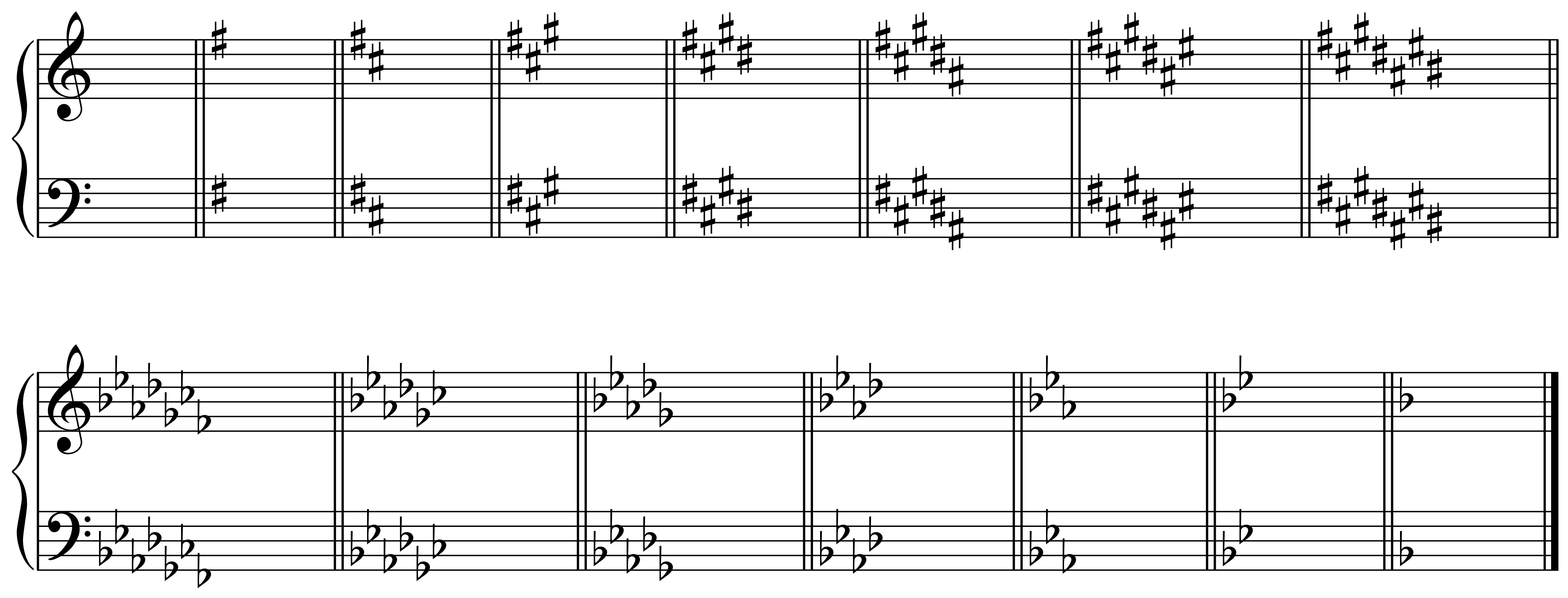Pitch Collections
As most music is made up of multiple pitches, we need ways to group notes to make sense of the music.
If we take some music by Mozart, we’ll notice that this section has seven different note names in it.
 [Piano Sonata No. 1 in C major, K. 279 by Wolfgang Amadeus Mozart, 1st movement, mm. 1-3]
[Piano Sonata No. 1 in C major, K. 279 by Wolfgang Amadeus Mozart, 1st movement, mm. 1-3]
We call this group of seven pitches a pitch collection. In common practice tonality, we have two main pitch collections, which you are likely already familiar with: major and minor.
These two kinds of pitch collections are related and most importantly, they have specific single pitches that are most important. We talk about C major and F minor. That word “tonality” back there is the idea we are talking about when we say that some music is in C major.
Our Mozart example has a pitch collection that fits all the notes of C major, as well as music that in many ways makes C the most important note. This is how we get the key of C major.
Now, we want easy ways to practice and recognize these keys. Previous musicians have created two ideas to help us learn keys quickly: scales and key signatures.
Major Scales
A scale is a specific ordering of a pitch collection starting on the keynote and ascending through the pitches.
This is the C major scale:

How do we make D major?
We need to find the relationships between the notes in C major to transpose our scale to start on D. This ascending pattern of steps is W W H W W W H (W=whole steps; H=half steps). So starting on D gives us:

Now how about F sharp major?

Writing all these accidentals gets to be a pain. If we know we are going to always use these specific accidentals in a piece of music, we need a way to only write them once rather than over and over again.
Major Key Signatures
A Key signature is a shorthand that allows us to read music that has accidentals in it. We place the key signature at the beginning of the staff rather than writing an accidental in front of each note. This save a lot of time writing the music down as well as speeding up reading time.
So we have a key signature for each key.

Minor
Now I said before that major and minor were related. Here’s one way: if we take the pitches of C major, but emphasize a different note, we can have a different scale. The minor key that shares C major’s pitches is A minor.

This relationship is called relative. C major and A minor are relative keys.
Another way is this: If we transpose A minor to start on C (like we did to make D major from C major), we get C minor.

Notice that C minor has three flats: B flat, E flat, and A flat. If we compare this with C major, we see that they share a key note, but have different key signatures. This relationship is called parallel. C major and C minor are parallel keys.
Now what’s interesting is that tonal composers make modifications to minor to make it more like major. This gives us three scale versions for minor:
- Natural
- Natural minor is the scale we saw above with A minor and C minor. This version matches the key signature.
- Harmonic

- Harmonic minor raises the seventh scale degree to match the parallel major. This note change helps make tonality happen by creating the needed half step below the key note.
- Note the three half steps between F and G sharp.
- Melodic

- Melodic minor smooths over the irregular F to G sharp by raising the sixth scale degreeas it ascends, and then lowering both pitches as it descends (to match natural minor).
- This scale allows for more regular sounding melodic motion in minor key music.
Minor key signatures match the major key signatures listed above. C major and A minor share a key signature of no accidentals. C minor and E flat major share a key signature of three flats, and so on.
Two Basic Key Relationships
As I noted along the way in the section on minor, we have two ways of relating certain major and minor keys.
- Relative – share a key signature (B flat major and D minor)
- Parallel – share a key note (G major and G minor)
For Practice
You should practice all of your major and minor scales to fluency. Start today; you will be a better musician for it. And it will make your time in theory classes a whole lot easier.
Make sure you can write and identify all of your key signatures quickly. This is a necessary skill for any musician who regularly plays music from notation.
Another important point: make sure you can tell minor key signatures just as well as major ones. Get in the habit of thinking of both when you see a key signature.